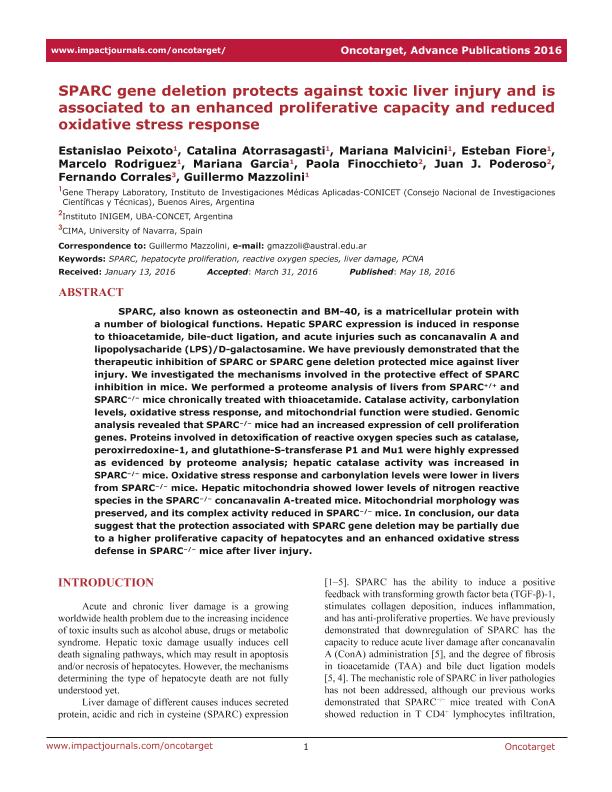Artículo
SPARC gene deletion protects against toxic liver injury and is associated to an enhanced proliferative capacity and reduced oxidative stress response
Peixoto, Estanislao ; Atorrasagasti, María Catalina
; Atorrasagasti, María Catalina ; Malvicini, Mariana
; Malvicini, Mariana ; Fiore, Esteban Juan
; Fiore, Esteban Juan ; Rodriguez, Marcelo; García, Mariana Gabriela
; Rodriguez, Marcelo; García, Mariana Gabriela ; Finocchieto, Paola; Poderoso, Juan José
; Finocchieto, Paola; Poderoso, Juan José ; Corrales, Fernando; Mazzolini Rizzo, Guillermo Daniel
; Corrales, Fernando; Mazzolini Rizzo, Guillermo Daniel
 ; Atorrasagasti, María Catalina
; Atorrasagasti, María Catalina ; Malvicini, Mariana
; Malvicini, Mariana ; Fiore, Esteban Juan
; Fiore, Esteban Juan ; Rodriguez, Marcelo; García, Mariana Gabriela
; Rodriguez, Marcelo; García, Mariana Gabriela ; Finocchieto, Paola; Poderoso, Juan José
; Finocchieto, Paola; Poderoso, Juan José ; Corrales, Fernando; Mazzolini Rizzo, Guillermo Daniel
; Corrales, Fernando; Mazzolini Rizzo, Guillermo Daniel
Fecha de publicación:
05/2016
Editorial:
Impact Journals
Revista:
Oncotarget
ISSN:
1949-2553
Idioma:
Inglés
Tipo de recurso:
Artículo publicado
Clasificación temática:
Resumen
SPARC, also known as osteonectin and BM-40, is a matricellular protein with a number of biological functions. Hepatic SPARC expression is induced in response to thioacetamide, bile-duct ligation, and acute injuries such as concanavalin A and lipopolysacharide (LPS)/D-galactosamine. We have previously demonstrated that the therapeutic inhibition of SPARC or SPARC gene deletion protected mice against liver injury. We investigated the mechanisms involved in the protective effect of SPARC inhibition in mice. We performed a proteome analysis of livers from SPARC+/+ and SPARC−/− mice chronically treated with thioacetamide. Catalase activity, carbonylation levels, oxidative stress response, and mitochondrial function were studied. Genomic analysis revealed that SPARC−/− mice had an increased expression of cell proliferation genes. Proteins involved in detoxification of reactive oxygen species such as catalase, peroxirredoxine-1, and glutathione-S-transferase P1 and Mu1 were highly expressed as evidenced by proteome analysis; hepatic catalase activity was increased in SPARC−/− mice. Oxidative stress response and carbonylation levels were lower in livers from SPARC−/− mice. Hepatic mitochondria showed lower levels of nitrogen reactive species in the SPARC−/− concanavalin A-treated mice. Mitochondrial morphology was preserved, and its complex activity reduced in SPARC−/− mice. In conclusion, our data suggest that the protection associated with SPARC gene deletion may be partially due to a higher proliferative capacity of hepatocytes and an enhanced oxidative stress defense in SPARC−/− mice after liver injury.
Palabras clave:
Sparc
,
Hepatocyte Proliferation
,
Liver Damage
Archivos asociados
Licencia
Identificadores
Colecciones
Articulos(IIMT)
Articulos de INSTITUTO DE INVESTIGACIONES EN MEDICINA TRASLACIONAL
Articulos de INSTITUTO DE INVESTIGACIONES EN MEDICINA TRASLACIONAL
Articulos(INIGEM)
Articulos de INSTITUTO DE INMUNOLOGIA, GENETICA Y METABOLISMO
Articulos de INSTITUTO DE INMUNOLOGIA, GENETICA Y METABOLISMO
Articulos(SEDE CENTRAL)
Articulos de SEDE CENTRAL
Articulos de SEDE CENTRAL
Citación
Peixoto, Estanislao; Atorrasagasti, María Catalina; Malvicini, Mariana; Fiore, Esteban Juan; Rodriguez, Marcelo; et al.; SPARC gene deletion protects against toxic liver injury and is associated to an enhanced proliferative capacity and reduced oxidative stress response; Impact Journals; Oncotarget; 5-2016; 1-11
Compartir
Altmétricas



